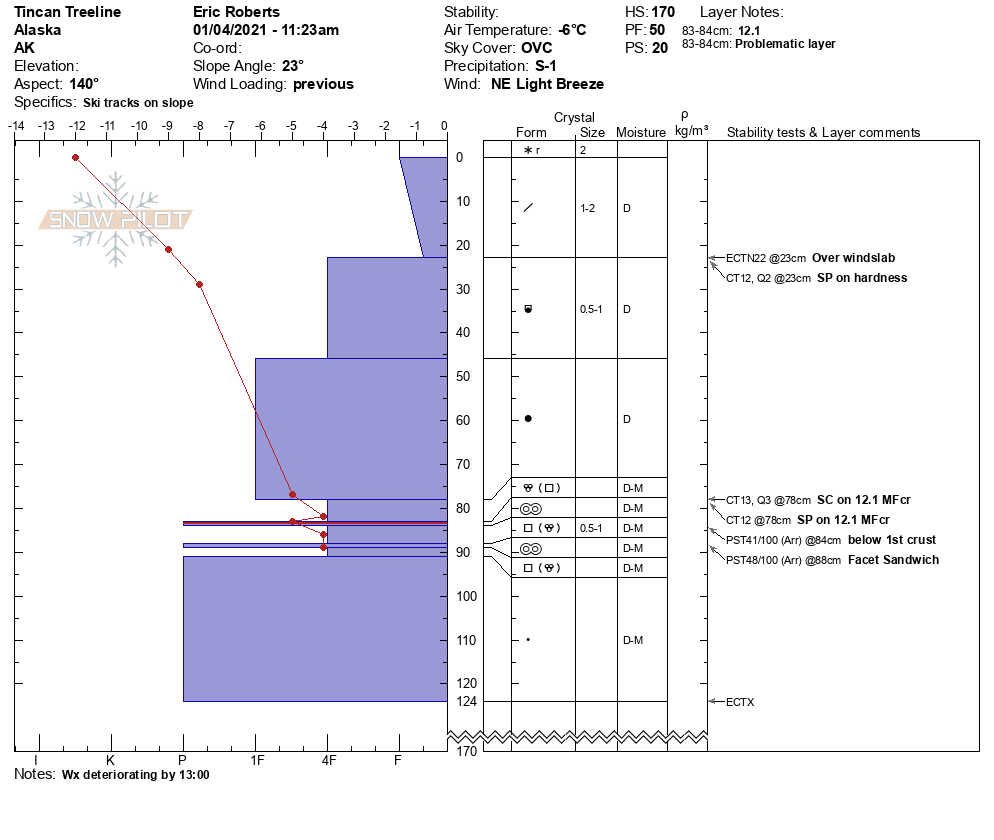No cracking, collapsing
Test slopes from 1,500’ to 2,200’ produced releases of 7” to 10” of low density snow over stiffer wind-packed surfaces.
Observation: Turnagain
Location: Tincan Treeline
09:45-14:15
Standard approach towards treeline to focus on the December 1st melt-freeze crust gradient, depth and reactivity as well as catch the vibe for the incoming storm. Though weather was gradually deteriorating by 13:00, skiing and visibility within treeline was great.
Overcast trending to obscuration as ceiling lowered from alpine to treeline, back to alpine.
Valley fog present from 800’ to 1,000’ near southern zone of Turnagain Pass.
Light NE wind trending to moderate N at 2,000’.
Active wind transporting observed 13:00 and on.
19°F at 1,000’ (10:00)
21°F at 2,200’ (11:20)
S-1 at 1,000’ (10:00)
S-1 trending to S1 at 2,000’ (12:00)
Active riming observed
1,000’ to 1,500’ showed 1” to 2” of fresh low density snow over a brittle 1cm crust with low density, settled powder below.
1,500’ to 2,200’ showed a mix of 5” to 8” of low density fresh and settled powder over various, supportable wind effected layers in exposed terrain.
Wind skins were developing by 13:00 as N winds increased.
The Dec 1st melt-freeze crust:
140 cm (4.5’) down at 1,700’ (HS 210 cm)
120 cm (3.9’) down at 2,200’ (HS 140 cm)
Ski/Boot penetration: 20 cm/50 cm
My focus was to assess the reactivity and depth of the Dec 1 melt-freeze crust layer, which is generally 3’ to 5’ below surface at treeline.
Tests at this location showed moderate to strong strength with propagation potential.
The Dec 1 crust layer, though reactive in small column testing (CT 12, CT 13), is showing strength in large column testing (ECTN 22, ECTX), which has been a trend for some time now.
The bed surface for the weak layer was rough, broken and irregular within the melt-freeze layer itself, in comparison to a more planar crust on results one week ago.
In addition, I received two PST results below 50% of the column , but due to the irregular structure of the tested weak layer, the columns self-arrested.
Though a temperature gradient is present to continue to produce faceting within the crust sandwich, irregularity within the structure could be a personal bias on placing the thermometer.
I also observed the Friday surface hoar feathers to be standing with fresh snow accumulating over. (See photo)
Overall, my take-away is that there is potential to trigger the Dec 1 melt-freeze crust/facet sandwich, but the terrain, including slope angle, would have to lend itself to the continuity of the weak layer, as the crust thickness, structure, and depths vary.
Test Depth: 125 cm
Height of Snow: 170 cm
*See Snowpilot*




